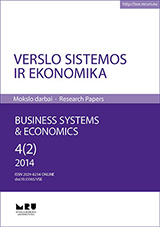NEMATERIALAUS TURTO SAMPRATA: IŠTAKOS, APIBRĖŽIMAI, SAVYBĖS IR ELEMENTAI
Intangible asset concept: economic thought development, definitions, peculiarities and element
Author(s): Artūras Jurgelevičius, Raimundas DužinskasSubject(s): Economy
Published by: Mykolas Romeris University
Keywords: intangible assets; historical development of intangible assets economic thought; intangible assets concept; intangible assets elements
Summary/Abstract: Classical economic theories can explain modern economic processes only to some extent. Economic growth theories were explained by many distinguished economists, such as Marx, Smith, Riccardo, Schumpeter, Becker and many others. The classical means of production were the main object in the interest of the economists researching and explaining economic growth. However, more sophisticated economy demands new methods and methodology to explain the same processes: growth, productivity, effectiveness, competitiveness. Unexplained growth in productivity in the second part of the 20th century was the beginning of new scientific research of intangible assets. However, at the time rapid growth in productivity was explained mainly by better human resources and technological progress. Intangible assets were not taken into account and were ignored by many economists and accountants for a long period of time because of the problems of identification, valuation and measurement of intangible assets. Various scientists of the field interpreted intangible assets according to their understanding. However, the growing number of literature on intangible assets suggests that this issue is becoming interesting enough and significant for the companies and economy in general. The aim of the paper is, after having analyzed economic thought development and discussing problematic issues of identification of intangible assets, to analyze elements of intangible assets and formulate universal definition of intangible assets. The object of the paper is intangible assets. The methods used are systematic classification and analysis of scientific literature in the field of intangible assets.
Journal: Business Systems & Economics
- Issue Year: 2014
- Issue No: 1
- Page Range: 204-216
- Page Count: 13
- Language: Lithuanian

